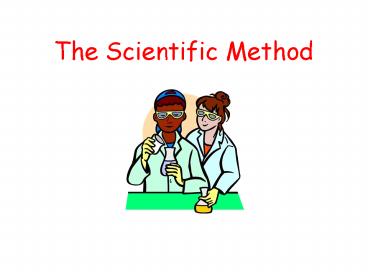The Scientific Method - PowerPoint PPT Presentation
Title:
The Scientific Method
Description:
The Scientific Method Definition-a series of steps that a scientist follows in order to solve a problem or answer a question. The steps may vary. – PowerPoint PPT presentation
Number of Views:267
Avg rating:3.0/5.0
Title: The Scientific Method
1
The Scientific Method
2
- Definition-a series of steps that a scientist
follows in order to solve a problem or answer a
question. - The steps may vary.
- An investigation is often sparked by an
observation.
3
- Step 1
- State the Problem or ask the Question.
4
- Step 2
- Gather Information (and start with your own big
brain.)
5
- Step 3
- Form OR state your HYPOTHESIS
6
Independent Dependent Variables
- Experiments have to be set up to test a specific
hypothesis and they must be controlled. - Controlling an experiment means controlling
all of the variables so that only a single
variable is studied. - The independent variable is the one that's
controlled and manipulated by the experimenter,
whereas - The dependent variable is not.
- As the independent variable is manipulated, the
dependent variable is measured for variation.
7
Experimental Group and Control Group
- Controlling an experiment also means setting it
up so it has a control group and an experimental
group. - The control group allows the experimenter to
compare his test results against a baseline
measurement so he can feel confident that those
results are not due to chance. - All other variables in the experiment must be the
same. (They are sometimes called constants.)
8
- Step 4
- Perform an Experiment
- to test your hypothesis
9
Step 5 Analyze your DATA.
10
Bias
- The scientific method attempts to minimize the
influence of bias or prejudice in the
experimenter. - Even the best-intentioned scientists can't
escape bias. - It results from personal beliefs, as well as
cultural beliefs, which means any human filters
information based on his or her own experience.
11
Supporting or Rejecting Hypotheses
- During an experiment, scientists collect data.
- Data is collected that will hopefully, support or
reject the hypothesis. - The ultimate goal is to prove or disprove the
hypothesis and, in doing so, answer the original
question.
12
- Data may be recorded and communicated through the
use of charts and graphs.
13
Draw a conclusion
14
- Experiments must be repeated
- before results are communicated with others!
15
Theories
- When a hypothesis or a group of related
hypotheses have been confirmed through repeated
experimental tests, it may become a theory. - Theories are much broader in scope than
hypotheses and hold enormous predictive power.































